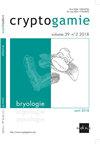A Small Elevational Gradient Shows Negative Bottom-to-Top Bryophyte Richness in a Seasonally Dry Forest in Brazil
IF 0.9
3区 生物学
Q4 PLANT SCIENCES
引用次数: 1
Abstract
ABSTRACT Elevational gradients can serve as powerful tools for testing ecological relationships between species richness versus environmental variables. Although the patterns be usually from positive to humped-shaped, elevational gradients may run in a negative way with the species richness decreasing in relation to the altitude. The floristic gradient may vary according species biology, site and, scale for analyses. Therefore, elevational gradient can be useful for detecting points for biological conservation and may be analized by using sensitive species as approach for others species including banner-species. Along an elevational gradient in a harsh semiarid environment we are showing a negative relationship between bryophyte species richness and increasing elevation. The observed floristic gradient reflects environmental constraints related to light requirements and low humidity as environmental conditions become more severe at higher altitudes, where anthropogenic activities such as farming dramatically alter the vegetation covering. The diversity of bryophytes in terms of their light requirements makes them excellent bioindicators of environmental quality. We provide data that will be useful for conservation planning and management, and report species with rare distributions in Brazil and others not yet recorded as occurring in dry forests.小海拔梯度显示巴西季节性干旱森林自下而上苔藓植物丰富度为负
海拔梯度可以作为测试物种丰富度与环境变量之间生态关系的有力工具。物种丰富度的分布格局通常由正向驼峰型转变,但海拔梯度可能呈负向变化,物种丰富度随海拔的升高而降低。植物区系梯度可根据物种生物学、地点和分析尺度而变化。因此,海拔梯度可以作为生物保护的探测点,并可以利用敏感种作为其他物种(包括旗种)的分析方法。在严酷的半干旱环境中,沿海拔梯度,苔藓植物物种丰富度与海拔升高呈负相关。观察到的植物区系梯度反映了与光照需求和低湿度相关的环境限制,因为在高海拔地区,农业等人为活动极大地改变了植被覆盖,环境条件变得更加严峻。苔藓植物在光需求方面的多样性使其成为良好的环境质量生物指标。我们提供的数据将对保护规划和管理有用,并报告在巴西和其他尚未记录的干旱森林中分布的稀有物种。
本文章由计算机程序翻译,如有差异,请以英文原文为准。
求助全文
约1分钟内获得全文
求助全文
来源期刊

Cryptogamie Bryologie
生物-植物科学
CiteScore
2.10
自引率
25.00%
发文量
12
审稿时长
3 months
期刊介绍:
Cryptogamie is a fully electronic journal, with a continuous
publication stream, devoted to a wide diversity of cryptogamic
topics, mainly in the taxonomic-phylogenetic field.
Cryptogamie, Bryologie accepts articles on systematics as
well as ecology and evolution of all of bryophytes.
Thematic issues may also be published under the responsibility of a guest editor.
 求助内容:
求助内容: 应助结果提醒方式:
应助结果提醒方式:


